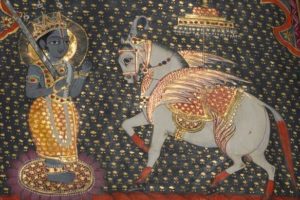
Direct devotional service is divided into five transcendental humors or flavors, and indirect devotional service is divided into seven transcendental humors.
Nectar of Devotion 34: Transcendental pleasure derived from devotional service can be divided into two groups: direct devotional service and indirect devotional service. Direct devotional service is divided into five transcendental humors or flavors, and indirect devotional service is divided into seven transcendental humors. Direct devotional services are as follows: neutrality, servitude, fraternity, paternity and conjugal love. Indirect devotional service is divided into laughter, compassion, anger, chivalry, dread, astonishment and ghastliness. Devotional service can therefore be divided into twelve types, each of which has a different color. The colors are white, multicolored, orange, red, light green, gray, yellow, off-whitish, smoky, pink, black and cloudy. The twelve different kinds of transcendental humors are controlled by different incarnations of God, such as Kapila, Mādhava, Upendra, Nṛsiṁha, Nanda-nandana, Balarāma, Kūrma, Kalki, Rāghava, Bhārgava, Varāha and Matsya.
Sustenance, manifestation, expansion, reflection and lamentation are the five visible symptoms in exchanges of ecstatic love. The test of devotional service can therefore be made in terms of these five symptoms. In the devotional service of neutrality there is sustenance, in chivalrous devotional service there is expansion, in compassionate devotional service there is reflection, in angry devotional service there is lamentation, and so on.
An apparently pitiable condition in devotional service may appear distressing to the inexperienced student, but the feelings of the devotee in this pitiable condition are considered to be ecstatic by expert devotees. For example, the subject matter of the Rāmāyaṇa is sometimes considered pitiable and distressing to the heart, but actually that is not the fact. The Rāmāyaṇa narrates how Lord Rāma was sent to the forest by His father just when He was going to be enthroned. After Lord Rāma’s departure, Mahārāja Daśaratha, His father, died. In the forest His wife, Sītādevī, was kidnapped by Rāvaṇa, and there was a great war. When Sītādevī was finally delivered from the clutches of Rāvaṇa, Rāvaṇa’s whole family and kingdom, and Rāvaṇa himself, were vanquished. When Sītādevī came home she was tried by fire, and after some days she was again banished to the forest. All of these subjects in the Rāmāyaṇa seem very pitiable, and they may appear very distressing to the reciter, but actually they are not. Otherwise, why would Hanumān, the great devotee of Lord Rāmacandra, read daily about the activities of Lord Rāmacandra, as described in the Rāmāyaṇa itself? The fact is that in any of the above-mentioned twelve transcendental humors of devotional service, everything is transcendentally pleasing.
Post view 554 times



Leave a Reply